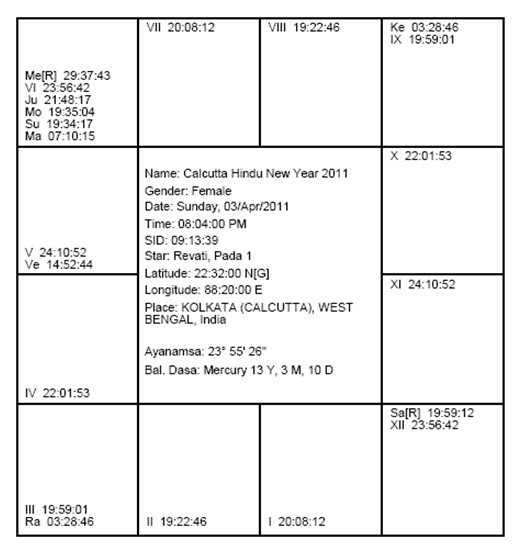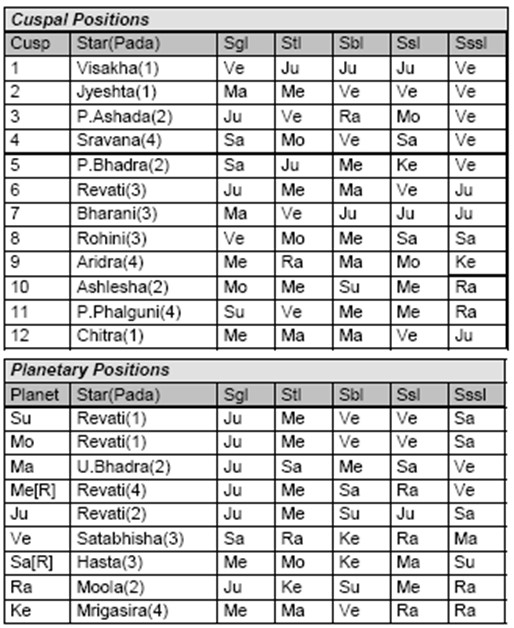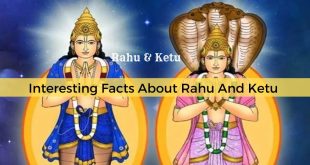Related Articles
A New Approach to Krishnamurthy Paddhati Mundane Analysis
Introduction
Krishnamurthy Paddhati (KP) technique of prediction, as propounded by late K.S. Krishnamurthy, do not contain any prediction rules for Mundane astrology such as predicting political elections, wars, earthquakes, stock price movements or any other matters of national economic and political importance. In fact, in the six Readers published by late Krishnamurthy ji there is only brief mention about whether politics will suit an individual and whether one can be selected as a minister in the third reader. But no where in all the six readers there is any clue regarding finding out various matters of national importance or Mundane astrology. Even in the old issues of Astrology & Athrishta magazine, which was published and edited by late Krishnamurthy ji, there is no mention of any mundane astrology article based on KP technique.
On the other hand in the field of Vedic astrology there is extensive literature available for Mundane astrology. Such literature is available starting from the classical texts to modern research. These literature give extensive rules of prediction pertaining to almost every aspect of national importance such as political elections, wars, earthquakes, stock market fluctuations, inflation-deflation, diplomatic relations, oath-taking or coronation etc.
However, KP technique is not having any such rule. Some KP astrologers try to do a horary or Prashna analysis taking a number between 1-249 for a specific query. This is not Mundane astrology but just an application of horary principles of KP applied on certain specific questions. That too, there is no original rule and some KP astrologers devise their own rules which may or may not have high degree of predictability.
Thus, this article is a novel attempt to make a link between the Mundane basis of Vedic astrology and application of KP rules. Probably, this is the first of its kind attempt being made in this regard with reference to a forthcoming election in the Indian state of West Bengal sometime in the month of May 2011. the article will be using the Hindu New Year chart of 2011 and apply the classical KP rules of winning elections and modern rules. The efficacy of this method can be known only after the declaration of the election results in May-June 2011.
The Context
West Bengal, which lies in the Eastern part of India has a Left Front government headed by the CPI(M) which has been uninterruptedly in office since 1977. It has won elections for seven consecutive terms. Late Jyoti Basu, the longest serving Chief Minister of any Indian state, laid down office after being the Chief Minister uninterruptedly for 23 years. After him, Sri Buddhadeb Bhattacharya was sworn in as the new Chief Minister on November 6, 2000. In the 2006 elections, the CPI(M) won 176 seats and the total strength of the Left Front in an assembly of 294 is 235. There are ten parties in the Left Front coalition.
The All India Trinamool Congress (abbreviated TMC or less commonly AITC, and also known as the Trinamool Congress, formerly West Bengal Trinamool Congress) is a political party in India. Founded in 1 January 1998, it consisted largely of defectors from the Indian National Congress in West Bengal. The party is led by Railway Minister Mamata Banerjee. Trinamool Congress is currently the second largest member of the ruling United Progressive Alliance (UPA) coalition. TMC was formed on 22 December 1997. Ms. Mamata Banerjee formed the “Trinamool Congress”, which was registered with the Election Commission of India during mid-December, 1997. In 2006 state elections in WB, TMC won 30 seats with Bhartiya Janata Party.
Job Charnock founded the city of Calcutta (now renamed as Kolkata), once the city of joy, in 1699 on behalf of the East India Trading Company. This was originally in the village of Kalikata on the bank of river Hoogly. Before the capital of India was moved to Delhi in 1912, Kolkata served as the capital of this nation from 1722. Today Kolkata stands as the capital of WB with lots of potential and promises. Whenever Bengal has become famous, it has been because of a person who with his work has brought fame to the state itself. People from the literary works seem to be the more famous one’s although there have been people who in other fields as well like arts, theater and cinemas. The most famous of all is definitely the legendary poet and Noble Laureate Rabindranath Tagore who won the Noble award in literature for his book of poems Geetanjali in year 1913. Another internationally acclaimed personality from Bengal was the renowned movie director Satyajit Ray who won was awarded an honorary oscar for lifetime achievement. Netaji Subhash Chandra Bose, Khudiram Bose and Sarojini Naidu were famous freedom fighters of India. They were not only respected in West Bengal, but were the leaders of freedom movement across India.
However, in various economic surveys and rankings, WB is consistently underperforming than rest of India. Increasing crime rate, poverty, de-industrialization and huge brain-drain has become a serious concern for all Bengalis in this state. The overall law and order situation in various districts is now very poor, condition of medical facilities is degrading, and huge immigrant influx from Bangladesh and downgrading of basic civic amenities is becoming intolerable for all in the State. Therefore, West Bengal’s election of 2011 will be an important determining factor for the state’s progress in the new decade.
The Analysis
Modern research on Vedic astrology also suggests that in order to make mundane analysis, it may be a good consideration to take the time of Hindu New Year beginning (Vikram Samvat) for the Capital of the country (By extending this logic we can also consider the capital of a State). It is pointed out by Vedic astrologers that the Hindu New Year chart shows all mundane trends for that year to come. As this is a precise time, this should also help us to look at the prospects of a State through the rules of Krishnamurthy Paddhati. So, we have taken the time at which Hindu New Year would start in 2011 and cast the Hindu New Year chart for Calcutta using Placidus House Division, Geocentric Latitude correction and KP Old Ayanamsa. The KP chart and the cuspal tables are provided below


Here we would analyze the Hindu New Year 2011 chart with the help of election rules of Krishnamurthy Paddhati based on modern research. But readers must note that the Hindu New Year chart is a mundane chart, and therefore all political matters are to be seen from the 10th house of this chart. Logically it will mean that the ruling government is the 10th cusp and the opposition is the 4th cusp.
For the benefit of all readers, let me reiterate the new KP rule of election winning: If the cuspal sublord of the 10th house is signifying houses 10, 3, and 11 then one can win an election. Readers must note that this is a KP rule which is basically meant for judging a Prashna or horary chart for an individual who would like to know whether he/she will win an election. This is not a mundane astrology rule. As an experiment however, we are only applying this rule to a Hindu New Year chart casted with KP principle.
On the other hand, the classical KP horary or Prashna rule for election winning is: For the ruling party/querist if the 6th cusp sublord is a significator of 6th and 11th and not signifying 5th and 12th then the ruling party/querist will win. But if the 7th cusp sublord (cusp of the opponent/Opposition) is a significator for 5th and 12th without signifying 6th and 11th house, then the opponent will win. (Readers must note that some KP astrologers also include the 10th house with 6th and 11th. But I am refraining from including the 10th house simply because the 10th house negates the 11th house by being 12th to the 11th house).
We would now examine the new KP rule as well as the classical rules to find out the fate of 2011 elections for West Bengal through the Hindu New Year Chart of 2011. In the HNY chart of Calcutta the 10th, 3rd and 11th cusp of the ruling CPI(M) government (actual 10th cusp of the chart) will be 7th, 12th and 8th cusps respectively. Whereas, for the Opposition (actual 4th cusp of the chart), the winning cusps of 10-3-11 would be 1st, 6th and 2nd cusps respectively. In other words, we are choosing the appropriate cusps after taking the respective ‘native’
For CPI(M): The 7th cusp sublord is Jupiter. Jupiter is in 5th but in close conjunction to the 6th cusp and owns 3rd and 6th house. Jupiter is untenanted and is the cuspal sublord of 1st and 7th cusp. Jupiter is in Mercury star, Sun subdivision. Mercury is in 6th house, owning 9th and 12th house. The sublord Sun is in 5th house, owning 11th house and untenanted cuspal sublord of 10th cusp.
For Opposition (TMC & Congress): The 1st cusp sublord is Jupiter again. Jupiter has been analyzed for CPI(M) above.
From both sides, it appears that the balance is tilted towards the opposition and not towards CPI(M), though complete clarity is not emerging.
We will now apply the classical KP rules to this NHY chart. For the ruling government the 6th and 11th house of 10th cusp will be 3rd and 8th houses. For the Opposition, the 6th and 11th cusps of 4th will be 9th and 2nd house.
For CPI(M): The 3rd cusp sublord is Rahu. Rahu is in 2nd house. Rahu represents Jupiter and so also signifies houses of Jupiter, that is, 3rd and 6th. Rahu is in Ketu star and Sun sub. Ketu is in 8th house. Ketu is aspected by Mars and Saturn. Mars is in 5th house owning 7th and 2nd house. Saturn is in 11th house, owning 4th and 5th houses. Saturn aspects 2nd and 9th houses. Sun is in 5th house owning 11th and is the untenanted cuspal sublord of 10th cusp.
The 8th cusp sublord is Mercury. Mercury is in 6th owning 9th and 12th. Mercury is in own star and Saturn sub. Saturn is in 11th house, owning 4th and 5th house.
For Opposition: The 9th cusp sublord is Mars. Mars is in 5th house, owning 7th and 2nd house. Mars is in Saturn star, Mercury sub. Saturn is in 11th house owning 4th and 5th house. Saturn aspects the 2nd and 9th houses. Mercury is in 6th house owning 9th and 12th house.
The 2nd cusp sublord is Venus. Venus is in 4th house owning 8th and 1st house. Venus is the untenanted cuspal sublord of 2nd and 4th house. Venus is in Rahu star Ketu sub. Rahu is in 2nd house, representing Jupiter and thereby signifying houses 3 and 6 and 5. Ketu is in 8th house. Ketu is aspected by Saturn and Mars. Saturn signifies 11, 4, 5 and Mars signifies 5, 7 2.
Conclusion
It therefore appears that the CPI(M) will be facing a very tough election not hitherto witnessed before. The appearance of malefic planets like Rahu, Saturn, Mars, Sun and Ketu at important cuspal points shows civil fights, bloodsheds, treachery and brutality. Though full clarity does not appear out of this chart, but surely Opposition is much well placed in the Hindu New Year 2011 chart to win the elections in West Bengal. It will not be surprising to see the CPI(M) government defeated in this election and the TMC-Congress joint force coming to power.
Learn Astrology: Join Our Upcoming Astrology Classes — Click Here
Learn Astrology: Join Our Recorded Astrology Classes — Click Here
 Saptarishis Astrology Magazine Into Creating Astrologers
Saptarishis Astrology Magazine Into Creating Astrologers






